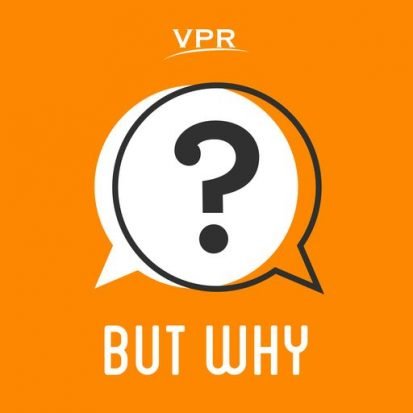
Do skyscrapers scrape the sky?
Leave a reviewWhy is the Burj Khalifa so tall? That’s what 5-year-old Simon wants to know. The Burj Khalifa is the tallest building in the world and it’s located in Dubai. 6-year-old Isabel, who lives in Dubai, visited the tower and gives us the bird’s eye view in this episode! Plus, Janny Gédéon, architecture educator and founder of ArchForKids answers lots more questions about tall buildings: How are tall buildings built? How do they stay up? Why are so many buildings squares or rectangles? How do they make buildings that are taller than cranes?
© Vermont Public Radio | 25:33
|Episode: 167 |
Full episode description
 Episode One: But Why: Intro For Adults
Episode One: But Why: Intro For Adults
This is an Episodic show. You can listen to it in any order, but episode one is always a great place to start.Full Episode description
Why is the Burj Khalifa so tall? That’s what 5-year-old Simon wants to know. The Burj Khalifa is the tallest building in the world and it’s located in Dubai. 6-year-old Isabel, who lives in Dubai, visited the tower and gives us the bird’s eye view in this episode! Plus, Janny Gédéon, architecture educator and founder of ArchForKids answers lots more questions about tall buildings: How are tall buildings built? How do they stay up? Why are so many buildings squares or rectangles? How do they make buildings that are taller than cranes?
Resources
Architecture workshops and online learning: ArchForKids
Download our learning guides: PDF | Google Slides | Transcript
Why is the Burj Khalifa so tall? – Simon, 5, Chicago
The Burj Khalifa is 160 stories tall. It measures over 2,716 feet tall – or if you think in metric that’s 828 meters. “If you put 450 grown ups stacked on top of each other, that would be the height of the building,” Janny Gedeon says.
Architecture is the science of designing buildings. Architects consider the purpose of the building and what it will be used for and then they design that space.
Square and rectangular buildings are less expensive to build, but architects do like to design buildings in interesting shapes. Check out the Lipstick Building in New York or the Gherkin in London, or the Sydney Opera House.
Tall buildings are more common in cities because they allow more people to live in a smaller space. They have to build vertically to fit more people in a small area. “The footing, the space that the building takes is not that big, so they have to build up,” Janny says. The footing is like your footprint, the amount of space you take on the ground. Manhattan is built on a very strong rock, so it can support those tall buildings.
Buildings stay up in much the same way humans stay up. There are footings–think of them like feet–that go into the ground. Buildings have a skeleton, called a structural frame, kind of like bones in a human. And on the outside, they have a cladding, aluminum or glass or other materials, kind of like our skin.
Wind is a big consideration for architects building tall buildings. They design the buildings to sway. If buildings are too brittle they will break, they are designed to sway. Most skyscrapers get narrower toward the top. In earthquake prone areas, buildings sometimes have footings on a track so they can move.
Activity
Try making the tallest tower you possibly can, just using paper. (Newspaper works great if you have some newsprint lying around. But printer paper or construction paper is fine, too.) You should focus on making it strong and stable. Strong means that it can hold something. Stable means that if it’s pushed to the side it can stay upright. You can use cardboard for the base, but otherwise, see how you can do with just paper. Need a hint? Janny says to think about the ways you’d stay stable when playing sports.
© Vermont Public Radiobop| Status: Active, 259 episodes | Kind: Episodic | Episode URL
The content, Artwork and advertising within this podcast is not owned or affiliated with Sound Carrot and remain the property of their respective owners.








